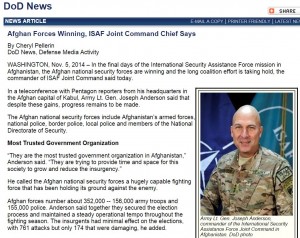Did ISAF Joint Command Chief Leak Classified Information on Afghan Troop Capabilities?
Recall that back on October 30, the Special Inspector General for Afghanistan Reconstruction informed us in a quarterly report that the military suddenly has classified its evaluation of the capabilities of Afghan National Security Forces (ANSF). One of the key commanders who may have been involved in this classification decision, Lt. General Joseph Anderson, who is the head of ISAF Joint Command, held a telephone briefing yesterday. The attached partial screenshot here shows the rah-rah article that DoD News put out covering the briefing. The headline blares “Afghan Forces Winning, ISAF Joint Command Chief Says” and opens with gushing praise for ANSF:
In the final days of the International Security Assistance Force mission in Afghanistan, the Afghan national security forces are winning and the long coalition effort is taking hold, the commander of ISAF Joint Command said today.
In a teleconference with Pentagon reporters from his headquarters in the Afghan capital of Kabul, Army Lt. Gen. Joseph Anderson said that despite these gains, progress remains to be made.
The Afghan national security forces include Afghanistan’s armed forces, national police, border police, local police and members of the National Directorate of Security.
“They are the most trusted government organization in Afghanistan,” Anderson said. “They are trying to provide time and space for this society to grow and reduce the insurgency.”
Ah, but did Anderson go too far? Recall that the evaluation of ANSF capability has been classified. Here is what comes next in the cheerleading article:
He called the Afghan national security forces a hugely capable fighting force that has been holding its ground against the enemy.
Hmmm. Is that a leak of classified information? Saying that ANSF is “a hugely capable fighting force” sure sounds like a statement based on an evaluation of ANSF capability similar to the evaluation that has been classified. Here once again is the SIGAR description (pdf) of the evaluation suddenly becoming classified:
This quarterly report also examines the reconstruction effort across the security, governance, and economic sectors. In the security sector, SIGAR was deeply troubled by the decision of the International Security Assistance Force (ISAF) to classify the executive summary of the report that assesses the capability of the ANSF. For years, SIGAR has used the ISAF report as a primary metric to show Congress and the public the effectiveness of the $61.5 billion U.S. investment to build, train, equip, and sustain those forces. Prior to this quarter, aggregate data on the operational effectiveness of the ANSF were unclassified in the Regional ANSF Status Report (RASR) as well as its predecessors, the Commanders’ Unit Assessment Tool (CUAT) and the Capability Milestone rating system.
ISAF’s classification of the report summary deprives the American people of an essential tool to measure the success or failure of the single most costly feature of the Afghanistan reconstruction effort. SIGAR and Congress can of course request classified briefings on this information, but its inexplicable classification now and its disappearance from public view does a disservice to the interest of informed national discussion. Moreover, while SIGAR understands that detailed, unit-level assessments could provide insurgents with potentially useful intelligence, there is no indication that the public release of aggregated data on ANSF capabilities has or could deliver any tactical benefit to Afghan insurgents.
So ISAF classifies the Regional ANSF Status Report but then unleashes the chief of ISAF Joint Command to make a statement that ANSF is “hugely capable” even though, as SIGAR notes, the public now has no way to have an “informed national discussion” on whether Anderson’s claim has any basis.
I’m sure that leak investigation will get started any century now.


Stripes on this interview:
This was at the end of the interview. After a question on ANA losses General Anderson destroyed all the gran claims he had previously made on wonderful ANA capabilities.
So the ANA is suffering unsustainable casualty rates, recruiting is down, the AWOL rate is unmentionable, and the force is only 81% and dropping. This negates what the general said earlier:
Yet another Petraeus, lying his boots off.
Jeez, let’s support jw.
.
Can’t somebody say something? Come on, gang.
.
Not a big deal. The post has gotten at least 20 tweets.
.
And it is hitting the desired audience. The author of the DoD News article followed me on Twitter this afternoon.
cool — you earned it
Here’s the interview, BTW, which I neglected to link.